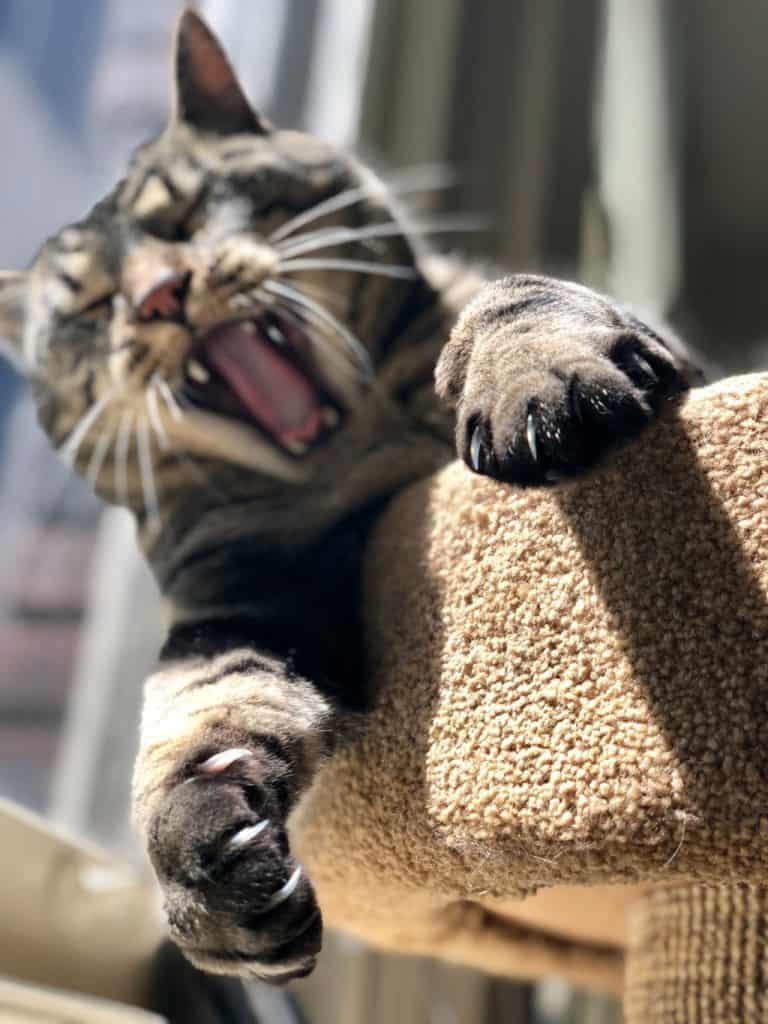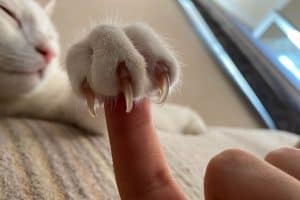You may feel that declawing a cat will solve scratching issues, and you want to try and do it yourself. If you’re on the fence about this, please do not do this. Here’s why:
Declawing is one of the most invasive treatments that can be performed on a cat. Every finger’s initial knuckle is being severed. The process, involving anesthesia, would usually take many hours. Never attempt to declaw a cat yourself. It’s a surgical procedure that requires an expert.
This article explores the risks of declawing (by a professional), the ethical issues, and some excellent alternatives to declawing.

What Are the Risks of Declawing a Cat?
Declawing is a surgical procedure that removes an animal’s claws by amputating all or part of the distal phalanges, or the end bones, of the animal’s toes.
The three methods of declawing are the scalpel, guillotine, and laser. All three require general anesthesia. Both the laser and the guillotine take roughly the same amount of time. Though laser declawing is sometimes marketed as less invasive, it still causes trauma to the cat’s paws, altering their natural stance and potentially leading to chronic pain and behavioral changes.
Declawing can cause pain in the paws and back, as well as infections, tissue death, and lameness. Removing claws alters how a cat’s foot contacts the ground and can cause pain. Claws that have been improperly removed can regenerate, causing nerve injury and bone fractures.
In a nutshell, claws are a birthright body part of a cat that provides a critical neurological, physiologic, and behavioral role for them.
Cats are instinctual hunters. Therefore, removing their fighting and hunting mechanisms may result in behavioral disorders. Cats nearly always try to scratch posts, furniture, and other objects. They can harm the amputation site in this manner long after the procedure.
It is not uncommon for cats to experience behavioral difficulties following a declaw. They can include increased hostility, a propensity to bite, and litter box problems.
While some may consider laser declawing a more ‘modern’ approach, it’s crucial to understand that, much like scalpel and guillotine methods, it results in the same amputation of the toe bones and can lead to significant post-operative complications.
Is It Cruel to Declaw an Indoor Cat? (arguments)
The debate on the ethics of declawing often circles back to one core principle: cats’ innate nature. Altering this can lead to significant distress and behavioral changes, even if the procedure appears ‘clean’ as in laser declawing.
At its heart, the ethical dilemma revolves around our duty as caretakers: is it our right to modify a creature’s physical state merely to fit our domestic needs? Here’s how the typical arguments go:
People who advocate declawing claim that declawing a cat is not unethical if done gently and with the animal’s comfort and safety in mind. According to them, the cat suffers no harm, and the owner benefits.
Those who oppose declawing argue that it causes cat pain and psychological distress for cats, because the cat will try to act as if they had claws only to be frustrated by their inability to complete the task.
Those who oppose declawing claim that it makes a cat helpless and unable to provide for itself, leaving it vulnerable if it lives outside. They also claim that it can make them more aggressive and possessive, resulting in a loss for the owner because this behavior can damage them and ruin their possessions.
They contend that the data supporting the practice is dubious, at the very least. In this approach, they argue that declawing harms both the cat and the owner.
Let’s assume, for a moment, that declawing a cat wouldn’t hurt the animal in any way. It would not disadvantage the cat or change its behavior for the purpose of this argument. Now the question becomes: Is it morally and ethically right to alter another living thing for our own convenience?
What possible argument exists for altering a cat in such a big way when a better-suited pet might be available? People aren’t usually forced to own a cat. Finally, a cat may not be the best decision if the furniture is so pricey.
Remember that this differs from spaying or neutering in that it reduces the misery and death of homeless cats rather than safeguarding furniture.
When we look at it this way, declawing a cat is a petty display of selfishness, an unwillingness to sympathize with other living beings at best, and a cruel, excruciating act at worst.
In a nutshell, declawing is deemed inhumane by most people. Declawing a creature that walks on its fingertips means cutting the finger at the first knuckle. As a result, it is considered cruel unless medically essential. Furthermore, declawing can negatively affect a cat’s mental health.
How Do Vets Feel About Declawing?
Since declawing is banned in many developed nations, most veterinarians will no longer perform it.
Many people believe adapting the cat for the owner’s convenience is cruel. The veterinarian’s role is to advocate for and protect the patient’s welfare, to provide direction and education to the client, and to aid in the maintenance of the human-animal bond.
Many veterinarians voice concerns not just over the physical repercussions of declawing but also the ethical implications of altering an animal’s body for human convenience.
Once you declaw, there is no going back.
The irreversible nature of declawing serves as a poignant reminder that decisions made for transient conveniences can have lasting implications on a pet’s overall well-being.

Is It Illegal to Declaw a Cat?
At least 42 countries, most of which are in Europe, have made declawing illegal.
So far, just two states in the US have passed declawing bans. Maryland (in 2022) and New York are among them (in 2019). Declawing is also prohibited in a dozen cities/areas in the United States:
- Berkeley, California
- Austin, Texas
- California’s Beverly Hills
- California’s Burbank
- Denver, Colorado
- Madison, Wisconsin
- Pittsburgh, Pennsylvania
- St. Louis, Missouri
- San Francisco, California
- Santa Monica, CA
- California’s West Hollywood
Many state bills to ban declawing have recently been introduced in the United States. Such bans indicate that people all over the country realize that declawing is inhumane, or at least something we shouldn’t be doing.
What Can You Do Instead of Declawing?
The AVMA is a fantastic resource for cat owners on alternatives to declawing. These are some examples:
To stimulate complete stretching, provide appropriate scratching surfaces like dedicated scratching posts and tall boards. Catnip scenting can help.
Regular nail trimming every 1 to 2 weeks (here’s how to do it). A short trim protects you, your pet, and your family while also potentially saving your sofa, curtains, and other furniture.
Nail caps are small plastic covers you place over your cat’s nails to protect them from sharp claws. They are reasonably priced and should be changed every four to six weeks.
Positive reinforcement training, starting while kittens. Positive reinforcement is known as giving a reward, which is desirable, to improve the likelihood of that behavior recurring. Positive reinforcement is the most effective way for cats to learn.
Pheromones have been found in studies to help calm agitated cats. There are numerous pheromone sprays and plug-ins available (also called diffusers). By transmitting reassuring messages and reducing stress, synthetic calming pheromones for cats can help ease your cat.
Use sticky tape or tinfoil to restrict the use of unwanted surfaces. The sticky sensation of the tape repels cats, which is why it’s such an effective deterrence technique. This eventually leads to them developing the habit of not scratching on the areas where you don’t allow.
Understanding the full breadth of consequences – both physical and psychological – associated with declawing is essential. There’s a reason many experts in the field rally against it, advocating for more humane alternatives.
FAQs
Is laser declawing better than a traditional one?
Laser declawing reduces the risk of infection and post-operative bleeding, although the cats are nonetheless bandaged as a precaution. Laser declawing is a permanent method of declawing cats that ensures the claws do not regrow. However, it carries the same drawbacks and dangers for the cat.
Does Petco declaw cats?
Declawing a cat can cost between $250 to $1800, depending on the cat’s age, weight, and overall health. As cats age, they put more weight on their paws and develop larger blood vessels. This involves a longer surgery and added recovery and pain management considerations.
Do cats know they are declawed?
Declawed cats appear to be unaware that they lack claws. They may, however, recognize they cannot protect as well as they formerly did. A declawed cat will bite when threatened and be more readily scared than before the surgery.
Alex, a passionate animal lover, has experience in training and understanding animal behavior. As a proud pet parent to two dogs and three cats, he founded AnimalReport.net to share insights from animal experts and expand his knowledge of the animal kingdom.




